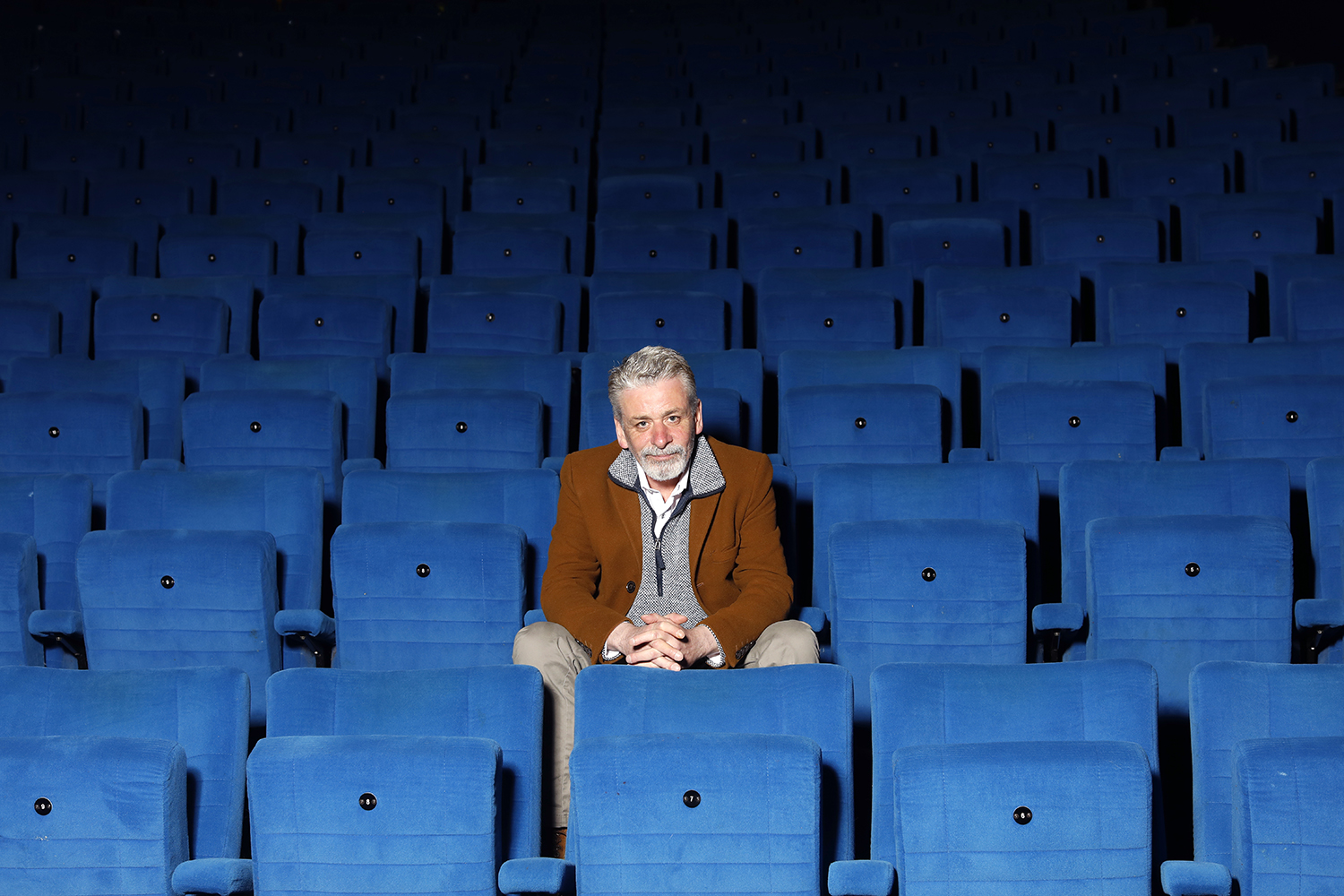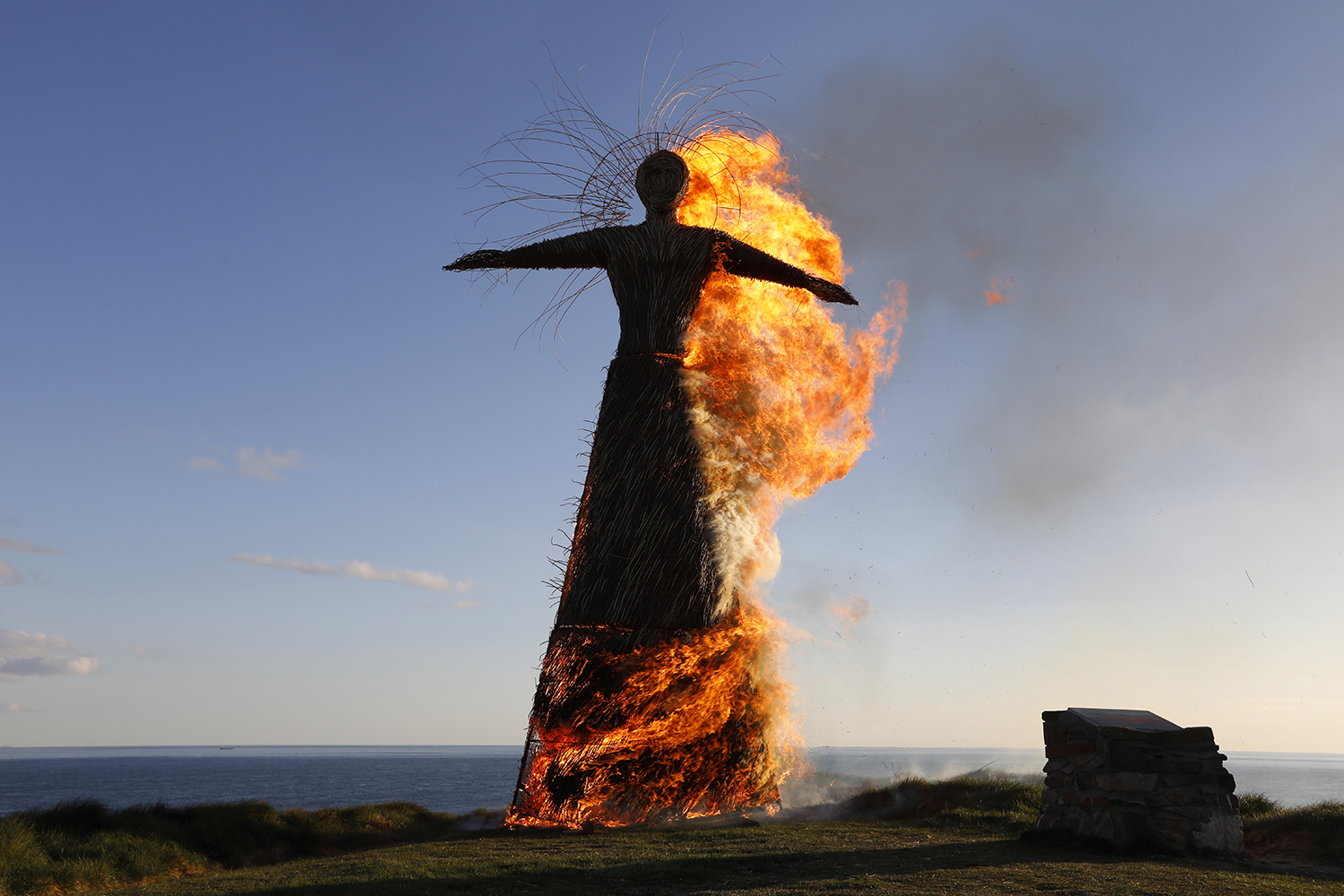Photography by Katherine Anne Rose
As the sun sinks over the Irish Sea, Fergal O’Riordan stands on a headland in south-west Scotland and looks up with tears in his eyes at the 7 metre-tall wicker man, blazing against the darkening sky. Five years of work going up in smoke. He couldn’t be happier.
Dubliner O’Riordan first contacted me in February to tell me about a documentary he was making on Robin Hardy’s 1973 cult folk-horror classic The Wicker Man. The project had consumed him since 2020, costing him all his savings, and almost his marriage, his family and his sanity.
Publicity seeker, I assumed. But when I finally got to meet O’Riordan, 55, last weekend, for the premiere of his film, Return to Summerisle, in the small town of Newton Stewart, it became apparent that he had been deadly serious.
Here’s a brief primer for anyone unfamiliar with the film itself, with necessary spoilers: Edward Woodward’s uptight Christian police sergeant Neil Howie flies from the Scottish mainland to the remote, insular island of Summerisle to investigate reports of a missing child. He finds an isolated, pagan, sexually liberated community that appals his religious sensibilities, and one that seems to be actively obstructing his investigations into the missing girl.
Lord Summerisle (a scenery-chewing turn by Christopher Lee), the vivacious landlord’s daughter Willow (Britt Ekland), Ingrid Pitt’s librarian and Diane Cilento’s schoolteacher, Miss Rose, seem unconcerned about the missing child, and Howie is led a merry dance – literally – until the truth emerges: there is no missing child; he has been selected and guided to Summerisle to become a sacrifice in the hope of appeasing the old gods and rescuing the island’s failing crops. The movie ends with Howie burned alive in a huge wicker man, as the islanders joyously sing and dance all around him.
“There’s a line in The Wicker Man when the mum of the missing girl says to Sgt Howie, ‘You’ll simply never understand the true nature of sacrifice,’” O’Riordan tells me. He’s sitting in the empty auditorium of Newton Stewart’s art deco community cinema, which the previous night was filled with almost 200 people watching his film. By his own admission he’s running on coffee and cigarettes. “I’m broke, my savings are gone, I was at the point where I wasn’t sure if I could afford to come over here for my own premiere, I’m pissing off my wife. But for me it was, like, ‘I have to get there, no matter what, I have to do this.’”
O’Riordan first saw the film on TV when he was 14. “I’m not sure why, but it just hugely affected me,” he says. “I could never stop thinking about it. I was too young to watch it, certainly too young to be comfortable watching a naked Britt Ekland in front of my father and mother. In the past few years I’ve heard a million stories from people about why the movie got them, and I suppose I’m a mix of all those stories. Some people want to be drinking in the pub with the crowd, singing those folk songs, others want that sort of hippy-esque lifestyle, some want the razor’s edge of that final scene...”
O’Riordan’s own obsession crystallised during lockdown, His wife, Claudia, suffers from MS, and when Covid hit she was confined to their house in Ireland, having been advised to shield. One day in 2020, O’Riordan burst into their living room and demanded she film him on her phone. “She thought I was going to do a magic trick or something, to cheer her up,” he says. “Instead I told her I was going to make a documentary about The Wicker Man, and I wanted that moment recorded when I said it out loud for the first time.” She shook her head, he recalls, and said, “Jesus Christ.”
Robin Hardy sacrificed his family when he made the film, there’s no doubt about that
O’Riordan is somewhat perplexed by his compulsion. He is not a film-maker of any kind. He has a full-time job working for a Dublin-based IT company. But once the idea had lodged itself in his head, there was no shifting it. When pandemic travel restrictions lifted, O’Riordan suggested a short break for him and Claudia. Scotland, he thought. Wide-open spaces, fresh air. And also, he’d learned, the locations where The Wicker Man was shot between November 1972 and January 1973 were all pretty much bunched together in Dumfries and Galloway. “I was just looking at all these locations and thinking: you know, there’s not long left to do this, to get hold of anyone who’s still alive who was involved with the film. So that settled it for me.”
Many of the surviving members of the cast were children when it was filmed. Lesley Mackie, who later went on to win an Olivier award for her stage portrayal of Judy Garland, was 21 when she played schoolgirl Daisy in a memorable scene where Sgt Howie visits the schoolhouse. Daisy points at a beetle in a desk, tied to a nail. Mackie was back in Newton Stewart last weekend after being interviewed for the documentary. “I got the part through my agent,” she tells me. “I was just told she was a naughty girl. I didn’t realise it was a key scene until later, because that beetle trapped by the nail represents Howie and how he doesn’t realise what’s happening to him.”
Another returnee to Newton Stewart was Jennifer Martin, who was 12 when she played Myrtle Morrison, quizzed by Howie about her missing sister. Martin says: “I’ll be honest with you, I barely gave the film another thought until two years ago when my daughter said, ‘Have you seen all the things on Facebook about that film?’ It was the 50th anniversary. It’s really interesting how it was ignored for so long and then suddenly everyone knows it.”
Perhaps the most affecting scene in the documentary is when Amy Rafferty is taken back to Anwoth church in nearby Gatehouse of Fleet. She appeared as a six-week-old baby in the original film, nursed by her mother, Barbara. Now a poet and singer with her band the Recovery Club, Rafferty performed at the premiere. In the documentary she is clearly emotional at being taken back to the old church and feels a connection with her mother. “It’s crazy how the film is so popular now,” she says. “I got a message from a fan on Facebook saying, ‘Are you the baby from the film?’ And that led to Fergal getting in touch. It’s been so lovely to be part of the documentary.”

The only surviving person who wouldn’t take part was Britt Ekland. A couple of years ago, O’Riordan found out that the actor – who famously had a body double for her nude scenes – was appearing at a horror convention in Sheffield. “I turned up and booked into the hotel next door for two days,” he says. “I sent her agent a message saying: look, I’m not going to move from this hotel room and if Britt wants to speak to me, I’m here. I mean, I could have gone into the convention and asked her, I suppose, but you have to draw the line somewhere. I’m not a stalker.”
O’Riordan started to spend money, buying himself cameras and kit costing thousands. Didn’t anyone take him to one side and suggest he might want to rein it in a little?
“Yeah, my wife quite directly on a number of occasions.” He looks thoughtful for a moment. “I’m not proud of that. You know, at one point, Claudia was in hospital. She’d had this really bad attack, and I left her hospital bed to go and do some filming. I had to be pulled back from the edge a couple of times. My sister said to me at one point, ‘I’m closer to Claudia than you are right now. She’s talking to me because you’re not talking to her.’”
O’Riordan falls silent in the darkened cinema, as if what he has been through, and put everyone else through, for five years has suddenly hit him. Claudia and his siblings – two brothers and two sisters – have all come over from Ireland for the premiere of his documentary, so he seems to have been forgiven. So how much did he spend, in the end? “I’ve agreed I’ll never mention that figure,” he says. “Claudia doesn’t want to know.”
Hardy died in 2016 but O’Riordan interviewed his sons Justin and Dominic, both also film-makers, for the documentary. “Robin Hardy sacrificed his family when he made the film, there’s no doubt about that,” says O’Riordan. “He got his chance to make his movie and he did it regardless of anything on God’s earth, and then he faded away big time and got divorced shortly afterwards. He’d had loans from his wife to make the film, they lost the house and ended up in poverty, his kids didn’t know he even existed for about five years. And I left my wife’s hospital bedside to go to do that interview with them. That irony isn’t lost on me at all.”

And that’s what O’Riordan has made a film about. The nature of sacrifice. But the documentary that was shown on the early May bank holiday weekend in Newton Stewart was not quite the finished product, because O’Riordan still had to film the final scenes. They would be taking place on the following Sunday evening at Burrowhead Holiday Village, some 20 miles south of Newton Stewart, overlooking the sea with the Isle of Man on the horizon.
“Are you here for the burning?” asks the woman in reception when I park up at the clifftop site with its caravans, chalets and tent pitches. On the tables outside, bemused bank holiday vacationers mingle with Wicker Man fans wearing animal masks and pagan garlands in their hair. And at the far end of the site, overlooking the sea, towers the wicker statue that O’Riordan has had made for his film’s coup de grace.
Several dozen fans of the film have assembled for this special event, recreating the final scenes of the movie, in which Sgt Howie, disguised in a Mr Punch outfit, is unwittingly led to the spot of his demise in a procession of Summerisle villagers dressed in a variety of costumes. A lot of work has gone into the masks and outfits, especially a note-perfect Punch, worn by a man called Gavin Eagleton-Muir, and made, he tells me, over three months by his wife, Lisa.
O’Riordan has erected his wicker man on the exact spot those scenes were filmed more than half a century before, and as the sun begins to dip – just as it did in the original film’s closing credits, while Howie was sacrificed still declaring his belief in a god that had not saved him – it bursts into flames.
“Is it over now?” I ask O’Riordan as he stares up at the blazing effigy, the crowd singing folk songs behind him. “Was it worth it?”
“I’ve promised my wife I won’t do any more interviews or filming after this,” he says. “Apart from Britt Ekland. If Britt says yes I can do that. If she’s in Australia I’ll swim there with my camera on my back.”
